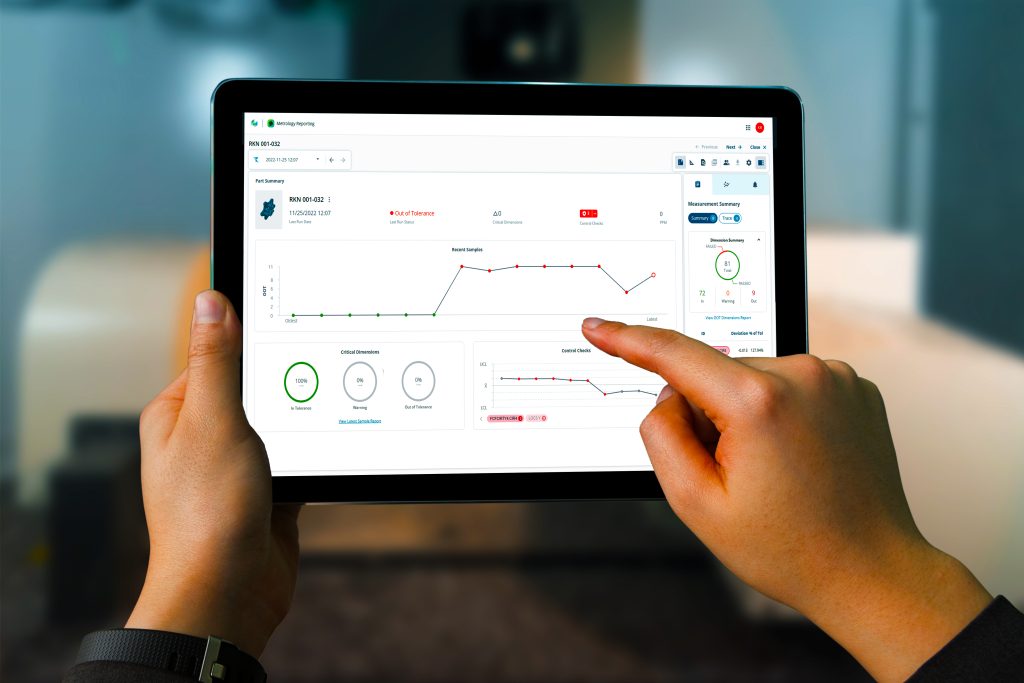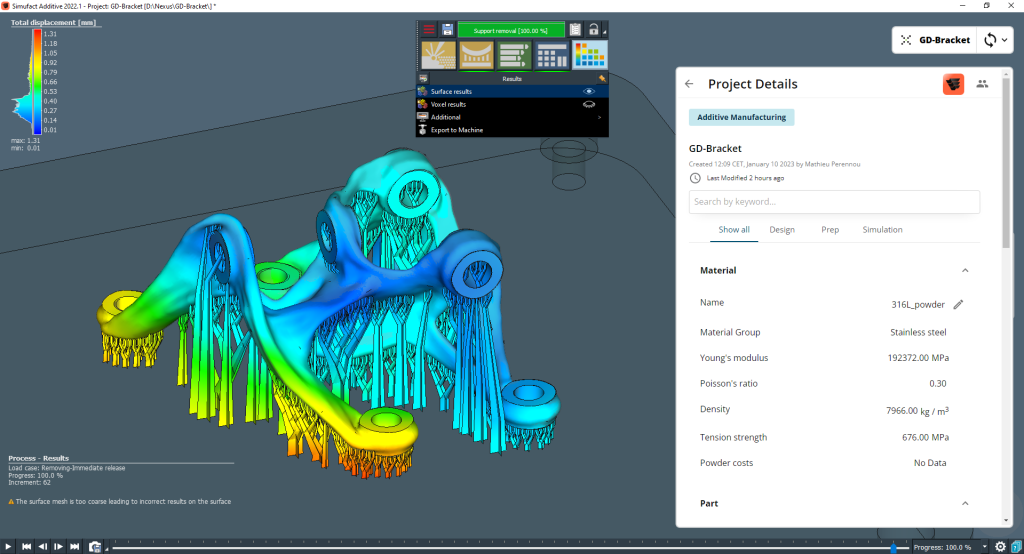Hexagon AB, an industrial software specialist, has launched Nexus, a platform co-engineered with Microsoft, for “the future of manufacturing.” The digital platform enables real-time collaboration between engineers and manufacturers across a product’s lifecycle, from design and engineering to production and quality. The Design for Additive Manufacturing (DfAM) capabilities provided by Nexus will particularly interest the 3D printing industry.
Hexagon, a global IT solutions provider valued at $292.52 billion, believes that the AM industry “has a problem,” with the siloing of data and limited internal collaboration “severely hampering progress.” This is according to Parth Joshi, Chief Product and Technology Officer for Hexagon’s Manufacturing Intelligence division, who outlines Nexus as aiming to “bring innovative minds together across disciplines and empower them” to tackle this.
3D Printing Industry attended the recent Nexus launch event and asked Mathieu Pérennou, Director Additive Manufacturing Solutions, Hexagon Manufacturing Intelligence, about how Nexus can be used for 3D printing applications. “This is our contribution to help people overcome data siloes,” said Pérennou. Nexus helps customers “use AM sooner and with greater confidence in the results.”
At launch, Stephen Graham, Executive Vice President and General Manager of Nexus, highlighted “openness” as key to this platform. “We’re building an ecosystem where you will be able to find and connect technologies from any vendor,” said Graham. “Pretty much anything that generates data in the context of discrete manufacturing can be connected to Nexus.”
Nexus includes three apps: a metrology reporting app; a cloud-based library for material data; and a material simulation app. Furthermore, Nexus also offers a DfAM workflow, billed as the platform’s first “solution.” This online interactive design platform enables teams to jointly develop 3D printed parts and prepare them for printing using the laser powder bed fusion (PBF) process. “Our new DfAM for PBF solution on Nexus offers more value than a single piece of software used in isolation,” Pérennou claims.
Nexus will not be limited to these three apps and the first DfAM “solution,” with new features set to be continually added over the coming months and years. Pérennou claims this is “what our customers are demanding and where the value lies.” “We are connecting workflows left and right. Key for us is connecting quality data and software so that we can start to close the loop further with production”.
Included from launch: three new Nexus apps
The Nexus Metrology Reporting app allows users to combine Hexagon and third-party metrology data within a cloud-based environment. This app enables increased productivity based on data-driven decision-making by providing real-time metrology information. By consolidating data into a centralized dashboard, this app is slated to make metrology data and reporting accessible for companies of all sizes. Indeed, there is no limit to the number of users who can log in and collaborate at any one time, making it scalable and able to support increased industrialization. The interface is also quite visual, providing colorful graphs and charts to help users easily identify relevant data. Users can log in at any time on any device and generate interactive CAD reports, KPIs and compliance documentation, and real-time data shared with customers, suppliers, and colleagues.
Materials Connect, another Nexus app, is a cloud-based material data library. “Material data is at the core of any product innovation process,” claims Graham, and Materials Connect provides a centralized and accessible database. Users can input data into an Excel template and then import this into the cloud-native database. The template includes guidelines for defining data attributes, properties, parameters, and curves without requiring extensive configuration. Imported data curves and parameters can be interactively visualized within the user interface. Hexagon states that this app can empower individuals to manage material, physical test data, and behavior models for Computer Aided Engineering (CAE) use. “By democratizing material data, it can help to drive productivity,” attests Graham.
Materials Enrich, which works with Materials Connect, is billed as a “first-of-its-kind Enrich app,” offering machine-learning and material behavior simulations. This app allows users to simulate and locate materials that may not have been created or previously tested. Data is imported from Materials Connect, and any missing data can be generated through simulations. The user can choose between enrichment technologies combining material modeling with machine learning. According to a fidelity indicator, the app generates data quickly and accurately, allowing users to save time and money relative to physical testing methods.

Design for Additive Manufacturing (DfAM), the first Nexus “solution”
Alongside apps, Hexagon also incorporates pre-configured workflows called “solutions” into Nexus, the first of which is focused on DfAM.
This designated workflow combines Hexagon’s MSC Apex Generative Design software with AM Studio from CADS Additive and Materials Connect via the cloud. Using this third-party software with Nexus allows for real-time collaboration and data sharing between all individuals involved in the design stage. Pérennou likens the MSC Generative Design software to a co-pilot “that can help the user quickly find a set of design candidates that satisfy the mechanical performance goal (stiffness, strength, etc.) with a highly optimized topology that’s what I’d call additive-friendly.”
Once the design phase has been completed, Hexagon’s Simufact Additive process simulation software can run simulations on the part, checking its manufacturability. The simulation engineer can work collaboratively and in real-time with the product designer and process engineer during this process. Thus the design and build prep of the part can be quickly tweaked to meet the customer’s requirements and ensure manufacturability. Once the design and test stages have been completed, AM studio can again be leveraged to prepare the job for printing.
Nexus’s DfAM also offers an interactive three-dimensional whiteboard, which enables all project members to collaboratively perform live project reviews. This platform provides 3D renderings of the project geometries and dynamic displays of the results generated throughout the DfAM process. Moreover, this whiteboard allows users to conduct real-time annotation and sketching on the 3D model.
New apps and “solutions” are set to be incorporated into Nexus regularly. For instance, in the future, Hexagon will connect Digimat, its material behavior modeling suite. Digimat will allow users to perform DfAM for a composite part and store the material properties, behavioral model, and any physical tests performed on the part in one place. “We’re working to make it easier to assess which parts are suitable for AM process, long before they dive into DfAM or scaling, and that – I think – captures what Nexus is for,” Pérennou says. “It’s about making it easier for people to make data-driven decisions and work together using their preferred tools from Hexagon.”

Key target markets and initial process platforms announced
By making the benefits of the cloud available without high costs, lengthy system integration, or IT expense, Hexagon claims that Nexus is designed to help companies of all sizes. Indeed, given the openness of Nexus, larger companies can connect teams using Nexus with their enterprise software platforms. Therefore, larger companies can utilize Nexus whilst maintaining their established business and regulatory processes.
Given its scope, Nexus targets several key AM verticals, such as medical, space and defense, aerospace, and industrial automation. Regarding DfAM, Pérennou highlights “OEMs, tier 1 suppliers or AM bureaus” as the key target market. Since Nexus’s current DfAM workflow is focused on metal PBF material, its key industry focus lies within aerospace, space, and defense. Yet, Pérennou indicates that DfAM will soon be extended to other processes, allowing customers to design for SLS and FDM or scale to larger parts and volumes with Metal Binder Jetting (MBJ) and Directed Energy Deposition (DED).
Design for Additive Manufacturing applications
DfAM is evident across manufacturing sectors. In the aerospace sector, GE unveiled its 3D printed advanced turboprop (ATP) engine, described as “the world’s first “digital native” aviation engine.” By using additive manufacturing, the number of components has been reduced by 30% compared to standard turboprop engines. Additive manufacturing allows for the consolidation of parts assemblies into single components; this can reduce weight, reduce space requirements, and even improve reliability as points of failure are removed.
Design software tools are particularly useful in unlocking the capabilities of additive manufacturing. For example, nTopology offers a suite of software, including generative design tools, and in 2022 launched, DfAM tools for its topology optimization platform. “This new technology will enable industry-first advancements such as field-driven optimization, where the software automatically designs lattice structures for user-defined objectives and constraints,” said Trevor Laughlin, VP Product at nTopology. “Ultimately, this will allow our customers to more efficiently make use of the AM design space, resulting in innovative applications faster than ever before.”
Subscribe to the 3D Printing Industry newsletter to ensure you keep up to date with the latest 3D printing news. You can also follow us on Twitter, like our Facebook page, and subscribe to the 3D Printing Industry Youtube channel to access more exclusive content.
Are you interested in working in the additive manufacturing industry? Visit 3D Printing Jobs to view a selection of available roles and kickstart your career.
Featured image shows the Nexus Metrology Reporting app in action. Photo via Hexagon.


